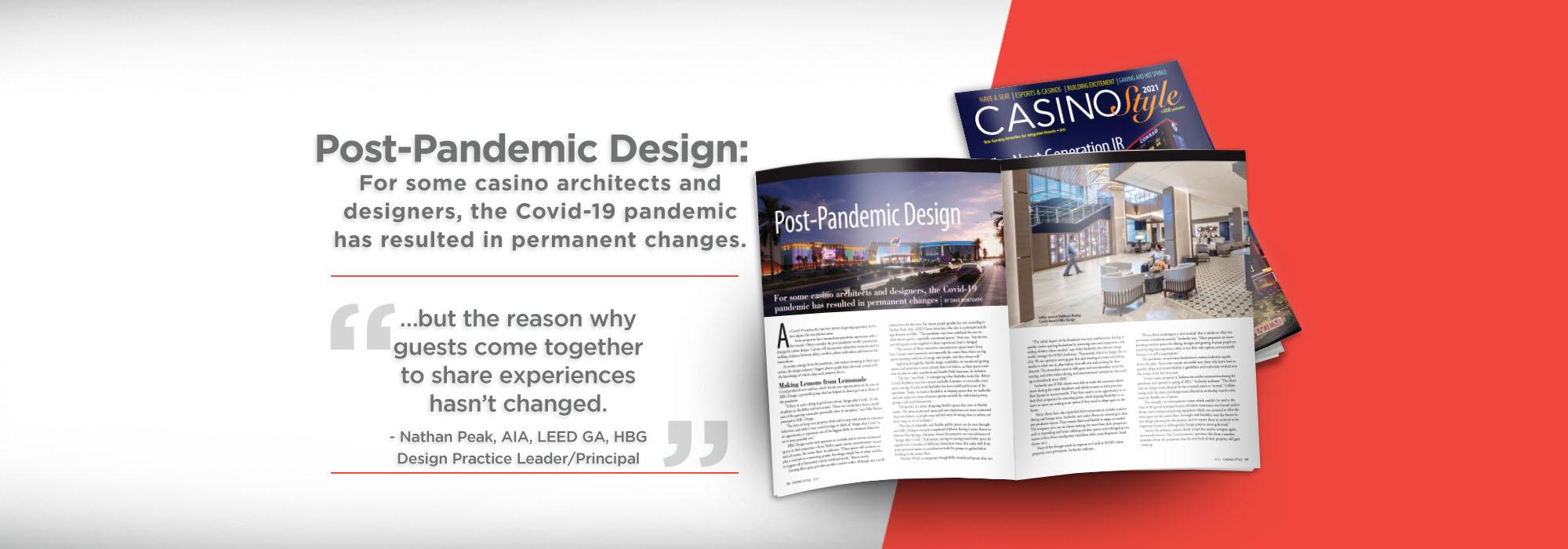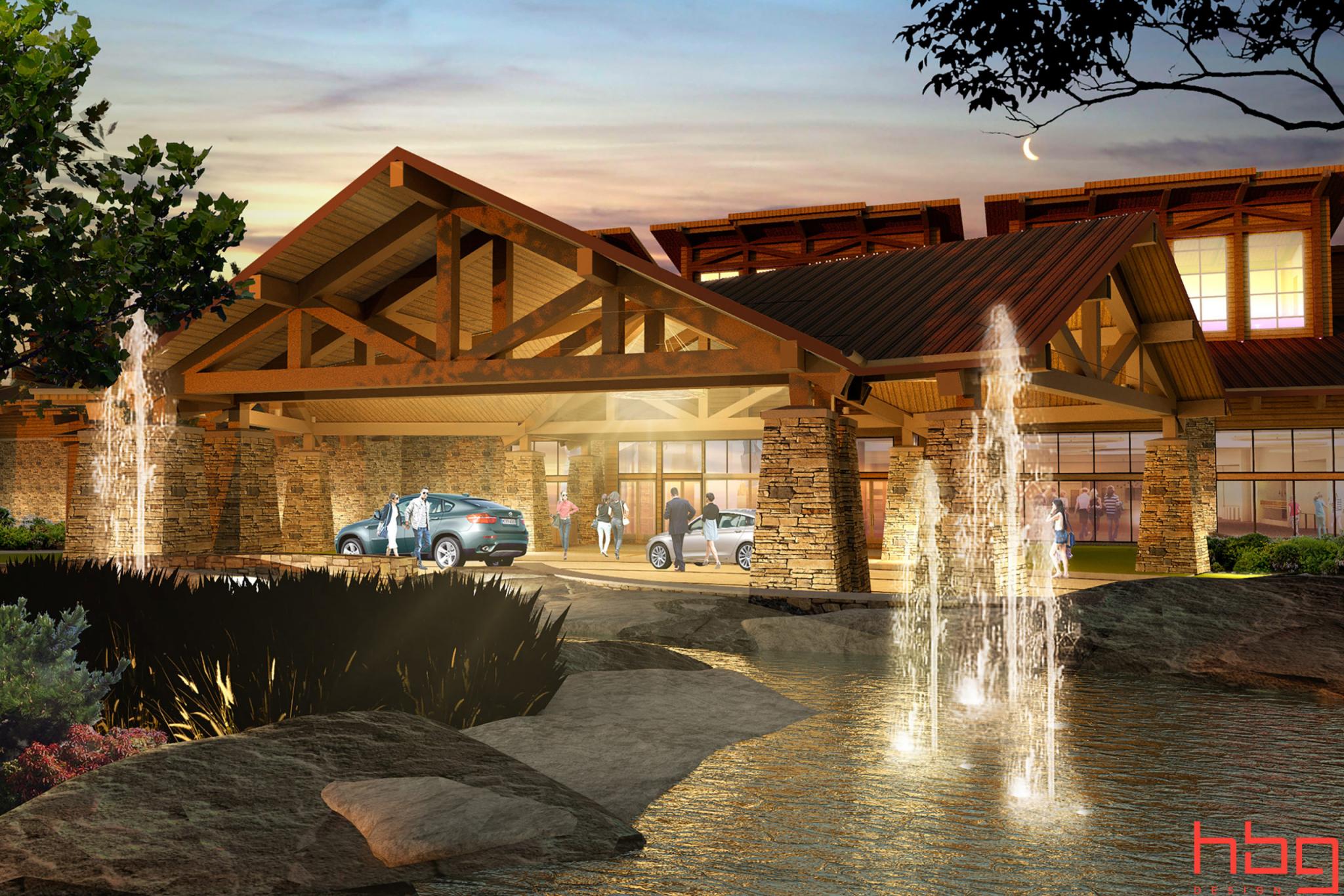GGB Casino Style Highlights Changes in Post-Pandemic Design
https://issuu.com/globalgamingbusiness/docs/casino_style_magazine_2021/16
As Covid-19 reaches the rearview mirror of gaming operators, its future impact fits two distinct areas. Some properties have resumed pre-pandemic operations with a few tweaks. Others consider the post-pandemic world a permanent change for casino design. Casinos will incorporate safety-first measures and try striking a balance between safety, comfort, player cultivation and bottom-line innovations.
As casinos emerge from the pandemic, and resume investing in their operations, the design industry’s biggest players guide them forward, armed with the knowledge of which camp each property fits in.
GGB Casino Style Highlights Changes in Post-Pandemic Design
Making Lemons from Lemonade
Covid produced new realities, which breeds new opportunities in the eyes of HBG Design, a powerful group that has helped its clients get out in front of the pandemic.
“If there is such a thing as good news about ‘design after Covid,’ it’s the emphasis on flexibility and reinvention. Those two words have been a steady part of the gaming vernacular practically since its inception,” says Dike Bacon, principal at HBG Design.
“You have to keep your property fresh and in-step with trends in consumer behaviors, and while it may sound strange to think of ‘design after Covid’ as an opportunity, it represents one of the biggest shifts in consumer behaviors we’ve seen, possibly ever.”
HBG Design works with operators to re-think and re-invent communal spaces in their properties—from F&B to guest rooms, entertainment venues and, of course, the casino floor, he indicates. “These spaces will continue to play a vital role in connecting people; the design simply has to adapt and flex to support all of humanity’s newly redefined needs,” Bacon asserts.
Gaming-floor space provides another creative outlet. Although new ramifications have hit this area, the reason people gamble has not, according to Nathan Peak, AIA, LEED Green Associate, who also is a principal and design director at HBG. “The pandemic may have redefined the way we think about spaces—especially communal spaces,” Peak says, “but the reason why guests come together to share experiences hasn’t changed.
“The essence of these interactive entertainment spaces hasn’t been lost. Casino resort amenities and especially the casino floor thrive on big spaces teeming with lots of energy and people, and they always will.”
Applying thoughtful, flexible design sensibilities to communal gaming spaces and amenities is more critical than ever before, as these spaces must now be able to easily transform and handle fluid situations, he indicates.
“The key,” says Peak, “is reimagining what flexibility looks like. Before Covid, flexibility may have meant stackable furniture or retractable event space seating, but the word flexibility has been redefined because of the pandemic. Today, we look at flexibility as shaping spaces that are malleable and can adjust to a host of layout options suitable for individual privacy, groups, and social interaction.
“Ultimately, it’s about designing flexible spaces that cater to flexible needs. The ideas of physical space and user experience are more connected than ever before, as people may still feel wary of sitting close to others, yet don’t want to be in isolation.”

High Limits area at Oaklawn Racing Casino Resort/HBG Design
The idea of adaptable and flexible public spaces can be seen throughout HBG Design’s recently completed Oaklawn Racing Casino Resort in historic Hot Springs, Arkansas. Across the property one sees influence of “design after Covid,” Peak asserts, noting its soaring hotel lobby space designed with a number of different interaction zones that easily shift from quiet personal spaces to socialization hubs for groups to gather before heading to the casino floor.
Flexible FF&E accompanies thoughtfully considered layouts that can be easily changed and reconfigured depending on the needs of operators and their guests.
“In the Oaklawn Racing Casino Resort lobby, we’ve used bold architectural gestures like the grand staircase and escalators which create dramatic structural elements and strong visual presence that directs casino guests to the main gaming floor, new food court and the hotel guest rooms on the second level,” Peak indicates. “Every space needs a moment that pulls you in, and these central elements draw you in, create interest and also provide a sense of openness in the space that puts guests in the right frame of mind—that they’ve entered not only a beautiful, glamorous entertainment space, but a safe space to enjoy.”
The pandemic has also seriously affected regional material sourcing, which plays a vital role in the architecture, engineering and construction (AEC) industry.
Bacon says a new sensibility about sourcing materials from regional makers and manufacturers has come out of the pandemic. “As designers seek to achieve an aesthetic that is of the area and create experiential moments, local and regional materials play a vital role in expressing that authenticity.
“Where the pandemic comes into play is in the material shortages, higher costs, and longer lead times the entire AEC industry is experiencing today,” he adds. “Covid created significant manufacturing shutdowns, especially overseas, leading to material shortages and often complete lack of availability, higher tariffs from international manufacturers shipping domestically and transportation concerns. As an alternative, carefully sourced regional options can not only circumvent such transportation and tariff issues, but they can also promote greater connection to place in meaningful ways.”
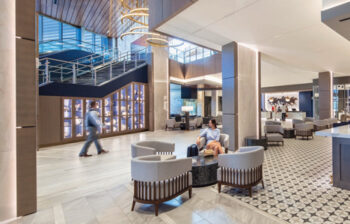
Lobby area at Oaklawn Racing Casino Resort/HBG Design
The effects of Covid extend to another area, the disrupted supply chains.
“Supply chain issues will probably go on for another year or so,” says Emily Marshall, IIDA, NCIDQ, principal and director of HBG Design’s Interior Design Group. “Many of our clients in the branded hospitality space, as well as in gaming, have told us they are looking at 30–32-week lead items for most of their FF&E and lighting. That makes a big impact on accommodating anticipated construction and installation schedules.”
One way HBG Design is working around the supply chain situation is by using more regional manufacturers who employ skilled tradesmen who build case goods and millwork in a shop, versus working onsite. This not only keeps the level of quality high, but also increases efficiency.
“We’re very supportive of this type of FF&E delivery because the craftsmanship is excellent and there is so much less waste as a result,” adds Marshall. “Like Dike said, if there can be any sort of ‘good’ outcome of the pandemic, it’s that our eyes have been opened to looking at everything from design to delivery through a different lens, while reimagining the way spaces are used, designed, and furnished. And that, in the long run, will be better for everyone.”
Read the full article above, and here.
Tule River Tribe introduces HBG Design as Architect & Interior Designer for new Eagle Mountain Casino
See full article in The Porterville Recorder
After breaking ground for its new casino located in Porterville last week, Eagle Mountain Casino is fast moving forward with the development of the casino.
The relocation of the casino to 40 acres of land located just south and adjacent to the Porterville Sports Complex has been 25 years in the making. The new casino will feature 1,750 slot machines, numerous table games, a 2,000-seat event center and restaurants throughout the 100,000 square foot property.
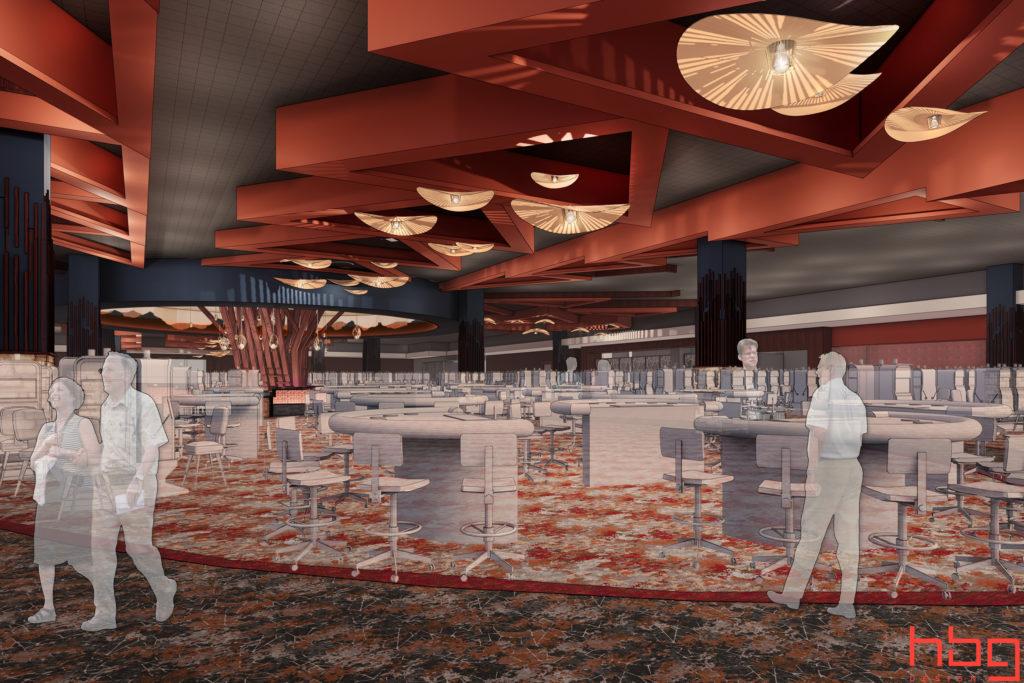 The relocation of the casino will free up water now being used by the casino for tribal members. The current casino will also eventually be used for additional medical facilities.
The relocation of the casino will free up water now being used by the casino for tribal members. The current casino will also eventually be used for additional medical facilities.
Nearly 200 people attended the groundbreaking including the Tule River Tribal Council, tribal members, Eagle Mountain Casino staff and many local dignitaries and political leaders. The ceremony began with a welcome from General Manager, Matthew Mingrone, followed by the presentation of colors by the Tule River Native Veterans Post of 1987 and a prayer and song by Tribal Elders J.R. Manuel, Rhoda Hunter and Tamara Seylaz.
 Honorable Tribal Speakers included: Tule River Chairman William Garfield, Vice-Chairman Neil Peyron, Councilman Felix Christman and Executive Director and Project Manager Ralene Clower. Honored Speakers included Congressman Kevin McCarthy, Senator Alex Padilla, Senator Shannon Grove, Assemblyman Devon Mathis, District Attorney Tim Ward, Tulare County Sheriff Mike Boudreaux, Porterville City Mayor Monte Reyes, National Indian Gaming Chairman Ernie Stevens, and Bureau of Indian Affairs Regional Director Amy Dutschke.
Honorable Tribal Speakers included: Tule River Chairman William Garfield, Vice-Chairman Neil Peyron, Councilman Felix Christman and Executive Director and Project Manager Ralene Clower. Honored Speakers included Congressman Kevin McCarthy, Senator Alex Padilla, Senator Shannon Grove, Assemblyman Devon Mathis, District Attorney Tim Ward, Tulare County Sheriff Mike Boudreaux, Porterville City Mayor Monte Reyes, National Indian Gaming Chairman Ernie Stevens, and Bureau of Indian Affairs Regional Director Amy Dutschke.
Tule River Tribal Vice Chairman Neil Peyron said during the ceremony, “This casino has been a long time coming. It's more than just a casino. This is education for our children, housing for our elders, and medical care for members of the tribe," Peyron said.
Boudreaux also announced at the groundbreaking the Tulare County Sheriff's Office would be the agency providing law enforcement for the casino.
Design Firm HBG Design and Construction firm W.E. O-Neil were the firms chosen by the tribe as construction begins this month.
HBG Design clients across the U.S. include more than 45 Indian gaming enterprises, and Commercial hospitality and entertainment giants such as Caesars Entertainment, Hyatt Hotels, Hilton Hotels and Elvis Presley Enterprises. HBG Design was recognized as an Associate Member of the Year by the National Indian Gaming Association for its support of Indian gaming tribes and Native American education programs. Visit www.hbg.design for more information.
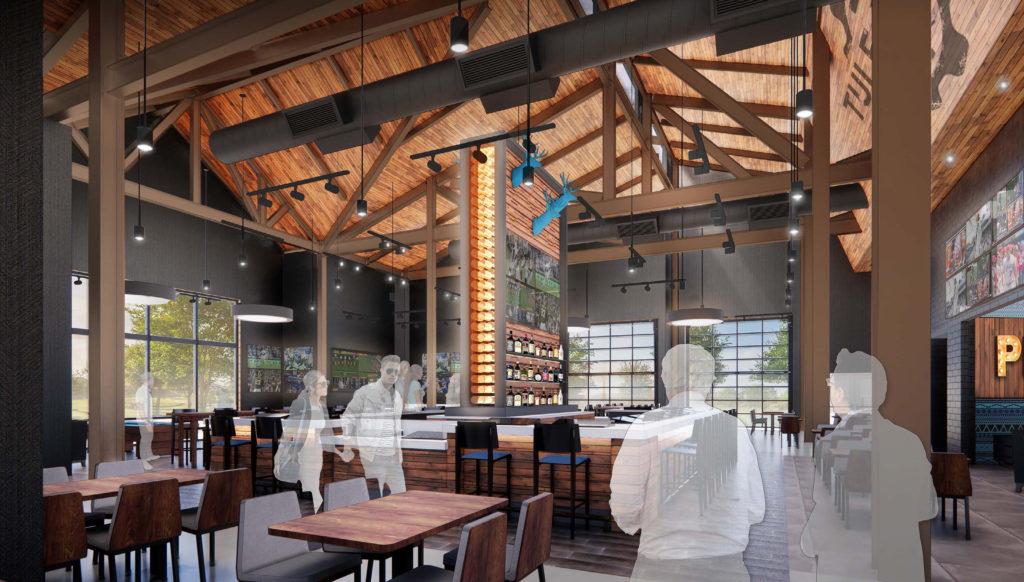 HBG's Joe Baraffaldi said the new casino's design will include Tule River heritage. The Sequoia tree canopy, trunk and roots of the Giant Sequoias are a main conceptual design of the casino.
HBG's Joe Baraffaldi said the new casino's design will include Tule River heritage. The Sequoia tree canopy, trunk and roots of the Giant Sequoias are a main conceptual design of the casino.
Baraffaldi said the Tule Tribe has been receptive to incorporating all of Tulare County's and Central California's cultural elements into the design. Artwork of the Tule River Tribe's native traditions will also be featured.
“Soaring vertical features will recall the majesty of the Giant Sequoia and the Golden Eagle,” Baraffaldi said, adding the Tule River will also be featured in the design.
A variety of tribal basket patterning will also be featured.
“Patterns and motifs of tribal symbolism will help draw guests through wayfinding paths, to the casino, the center bar, the dining venues and to ancillary spaces,” Baraffaldi said.
The Flight of the Butterfly will be featured at the entry and a mountain silhouette design that emulates the regional landscape will also be featured. The center bar will symbolize the idea of the fire as a place of gathering.
Casino guests will be welcomed with water features and a replica of the iconic tribal Painted Rock and Bigfoot pictographs found on Tule River Reservation lands.
The casino will feature a sports bar, food court and steak restaurant. With COVID safety measure in mind, instead of a buffet the casino will also feature a three-meal restaurant.
“We were able to create a new dining concept that will be even more comfortable and welcoming for patrons,” Baraffaldi said.
There's also been a investment in a premium air system. “The new casino is clean and safe for guests,” Baraffaldi said. “There are more robust safety elements designed into the new facility versus what an existing casino could provide.”
The casino is expected to open in December, 2022.
MBJ SWOT: HBG Design's innovation could pay dividends for its clients after COVID is over
See full article in Memphis Business Journal
by: Susan Ellis
Local economies are no different from organizations when it comes to taking stock of their ability to grow, innovate and thrive in lockstep with the times. Much depends on talent within: the employees of companies and nonprofits, the entrepreneurs who define a business community. But a lot also rides on the unique mix of ingredients that both define the local economy in question and play an outsize role in its success in navigating change or crisis. The SWOT analysis is nothing new for anyone familiar with business-school dogma, though its application to our small business community — as it rebounds from a pandemic — is probably a first. What follows is a breakdown of the strengths, weaknesses, opportunities and threats working for or against the region’s small-business owners as they climb back from one of the most economically and socially disruptive events in modern times.
MBJ SWOT: Weakness: Solutions when ‘all in’ might mean betting your life
One point the pandemic proved over and over again: The human body and economy are both highly susceptible to dramatic external forces like contagions, and the health and well-being of the first is inextricably linked to the ultimate success of the latter. When COVID started, Memphis-based HBG Design hit the drawing board to create solutions for its clients in the hospitality industry, whose revenue depended on the safety and confidence of customers. Their resulting innovation, Safebet, could continue to pay dividends long after COVID is gone.
HBG Design
Rick Gardner of the architecture/design firm HBG Design considers himself a “creative problem solver.”
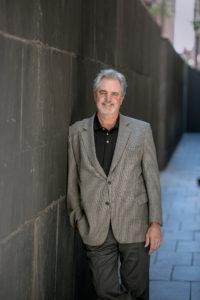
So, when the pandemic hit, he assigned his team to answer two questions: How will this pandemic affect business? And, how will it affect the way they approach design?
HBG specializes in work in the hospitality sector. Past projects include the Guest House at Graceland in Memphis and the Desert Diamond West Valley Casino in Arizona.
“We zeroed in on specific solutions,” he said. “We asked ourselves a very specific question that became the mission statement for Safebet: How do we make sitting on a stool in front of the slot machine the safest place on the gaming floor?”
Since games on the casino floor are often rearranged, the Safebet system is designed to work on all sorts of configurations — rows, carousel, and trios.
“The reason we zeroed in on [slot machines] as opposed to other places in the casinos is the slot revenue is the engine that drives resorts,” Gardner said.
In designing Safebet, HBG also considered user experience.
“Most people are uncomfortable with the way things were before the pandemic, sitting down next to a stranger in close proximity,” he said.
He noted that the walls can be removed for guests who want to play together on the machines.
HBG hooked up with manufacturing firm KGM Gaming to make the components of Safebet. That firm will also do the sales and marketing, while HBG will focus on R&D.
Gardner said there may be other applications for Safebet as well.
“We’ve focused first on the gaming side of things, but we’re looking at dining rooms for restaurants,” he said.
Gardner said that while many restaurants already use plexiglass, he envisions bringing that to a more “sophisticated” level. He pictures Safebet in convention centers and resorts. The average slot machine costs $20,000, Gardner said, with large casinos having roughly 1,500, for a total expenditure of $30 million. Something like Safebet could be a smart investment — not just for now but for the future.
“We’ve had all kinds of viruses and pandemics in the past 20 years — SARS, MERS, and all that stuff. And they came and went,” Gardner said. “But, [COVID-19] has affected us much differently. It’s been imprinted in our psyche. We’re not going to forget it. What we all know now is that there’s going to be something next.”

